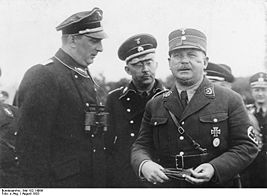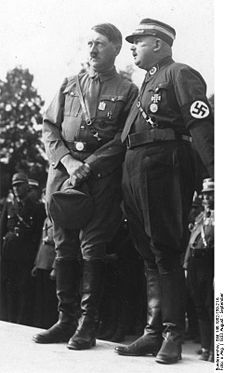[back] Nazi

Ernst Rohm
[back] Nazi
[Ernst Julius Röhm, (Munich November 28, 1887 – July 2, 1934) was a homosexual German army officer and Nazi leader. He was a co-founder of the Sturmabteilung ("assault battalion"; SA), the Nazi Party militia, and later was SA commander. In 1934, he was executed on Hitler's orders.]
See: Nazi list
Quotes
In a fascinating read of 204 well documented pages, the
authors of The Pink Swastika track down the facts behind the homosexual
movement’s current claims for Nazi-victim status. Divided into seven parts, the
story opens as the new Nazi party is founded in the smoky din of the
Bratwurstglockl, “a tavern frequented by homosexual roughnecks and
bully-boys....a gay bar,” favored by Hitler’s closest comrade, Captain Ernst
Rohm. Almost every biography of Hitler reports that Rohm was a flagrant
homosexual and the only man Hitler called by the familiar “du.”
Hitler’s beloved Storm Trooper Chief and founder of the
Brown Shirts, the authors note, had a “taste for young boys." Almost as close
to Hitler as Rohm was Rudolph Hess, known for his dress-up attire as “‘Black
Bertha’” in the gay bars of pre-war Berlin”.
In fact, Mein Kampf was dedicated to Hess while Hitler was in prison.
The Pink Swastika reports that Hitler was given power by a homosexual
gang, a gang says Dr. Carroll Quigley, President bill Clinton’s college teacher
and mentor, that subverted Germany’s free elections by underhanded and brutal
strategies. THE PINK SWASTIKA AND HOLOCAUST REVISIONIST HISTORY
by Judith A. Reisman, Ph.D.
Many of the highest-placed leaders in the Nazi party, including Hitler, Roehm, Forster, von Schirach and almost all of his bodyguards were gay. Hitler surrounded himself with homosexuals and even retrieved Roehm from Bolivia, making him Deputy Fuhrer. This knowledge enabled outside countries like Britain and ideologies like the Freemasons to control Hitler, his high command and his bodyguards. Hitler and his band of merry bandits became puppets with wooden strings. In this way, any foreign society can be destroyed with a leader hiding their sexuality. Hitler, Roehm, Forster and von Schirach took part in destroying their own societies while enjoying the power it gave them. Hitler was a double agent prime minister. He worked for a foreign country (Britain) and a foreign ideology (the Freemasons). The formula proved so effective it is still used today, in politics and the media, especially with TV personalities, radio announcers, prime ministers and presidents, both male and female. Hitler was a British Agent by Greg Hallett p.65
With Roehm's backing, Hitler became the first president of
the party in 1921 (ibid.:21) and changed its name to the National Socialist
German Worker's Party. Soon after, Rossbach's Storm Troopers, the SA, became its
military arm. In his classic Nazi history, The Rise and Fall of the Third
Reich, author William Shirer describes Roehm as "a stocky, bull-necked,
piggish-eyed, scar- faced professional soldier...[and] like so many of the early
Nazis, a homosexual"
......Betraying his roots in the "Butch" faction of the German "gay
rights" movement, Roehm viewed homosexuality as the basis for a new society.
Louis Snyder writes that Roehm "projected a social order in which homosexuality
would be regarded as a human behavior pattern of high repute...he flaunted his
homosexuality in public and insisted that his cronies do the same. What was
needed, Roehm believed, was a proud and arrogant lot who could brawl, carouse,
smash windows, kill and slaughter for the hell of it. Straights, in his eyes,
were not as adept in such behavior as practicing homosexuals" (Snyder:55). "The
principle function of this army-like organization," writes historian Thomas
Fuchs, "was beating up anyone who opposed the Nazis, and Hitler believed this
was a job best undertaken by homosexuals" (Fuchs:48f). The Pink Swastika by
Scott Lively and Kevin Abrams. The
Pink Swastika by Scott Lively and Kevin Abrams.
The Community of the Special (CS) asserted that male
homosexuality was the foundation of all nation-states and that male homosexuals
represented an elite strata of human society. The CS fashioned itself as a
modern incarnation of the warrior cults of ancient Greece. Modeling themselves
after the military heroes of Sparta, Thebes and Crete, the members of the CS
were ultra-masculine, male-supremacist and pederastic (devoted to man/boy sex).
....One of the keys to understanding both the rise of
Nazism and the later persecution of some homosexuals by the Nazis is found in
this early history of the German "gay rights" movement. For it was the CS which
created and shaped what would become the Nazi persona, and it was the loathing
which these "Butches" held for effeminate homosexuals ("Femmes") which led to
the internment of some of the latter in slave labor camps in the Third Reich.
The Pink Swastika by Scott Lively and
Kevin Abrams.
The "Butch" homosexuals of the CS transformed Germany.
Their primary vehicle was the German youth movement, known as the Wandervogel
(Rovers or Wandering Youth).
....Rising spontaneously in the 1890s as an informal
hiking and camping society, the Wandervogel became an official organization at
the turn of the century, similar to the Boy Scouts. From early on, however, the
Wandervogel was dominated and controlled by the pederasts of the CS. CS
co-founder Wilhelm Janzen was its chief benefactor, and its leadership was rife
with homosexuality. In 1912, CS theorist Hans Blueher wrote The German
Wandervogel Movement as an Erotic Phenomenon which told how the
organization was used to recruit young boys into homosexuality.
....During World War I, the greatest hero of the
German youth movement was Gerhard Rossbach. Described by historian Robert G. L.
Waite as a "sadist, murderer and homosexual," Rossbach was "the most important
single contributor of the pre-Hitler youth movement" (Waite,1969:210). More
importantly, Rossbach was the bridge between the Wandervogel and the Nazi Party.
....Rossbach's adjutant was Edmund Heines, noted for
his ability to procure boys for sexual orgies. Ernst Roehm, recruited by
Rossbach into homosexuality, later commanded the Storm Troopers for the Nazis,
where they were more commonly known as the SA (an acronym for Sturmabteilung).
The Pink Swastika by Scott Lively and
Kevin Abrams.
While Adolf Hitler is today recognized as the central figure of Nazism, he was a less important player when the Nazi machine was first assembled. Its first leader was Ernst Roehm. Homosexual historian Frank Rector writes that "Hitler was, to a substantial extent, Roehm's proteg�" (Rector:80). Roehm had been a captain in the German army. Hitler had been a mere corporal. After World War I, Roehm was highly placed in the underground nationalist movement that plotted to overthrow the Weimar government and worked to subvert it through assassinations and terrorism. In The Order of the Death's Head, author Heinz Hohne writes that Roehm met Hitler at a meeting of a socialist terrorist group called the Iron Fist and "saw in Hitler the demagogue he required to mobilize mass support for his secret army" (Hohne:20). Roehm, who had joined the German Worker's Party before Hitler, worked with him to take over the fledgling organization. With Roehm's backing, Hitler became the first president of the party in 1921 (ibid.:21) and changed its name to the National Socialist German Worker's Party. Soon after, Rossbach's Storm Troopers, the SA, became its military arm. In his classic Nazi history, The Rise and Fall of the Third Reich, author William Shirer describes Roehm as "a stocky, bull-necked, piggish-eyed, scar- faced professional soldier...[and] like so many of the early Nazis, a homosexual" The Pink Swastika by Scott Lively and Kevin Abrams.
Betraying his roots in the "Butch" faction of the German "gay rights" movement, Roehm viewed homosexuality as the basis for a new society. Louis Snyder writes that Roehm "projected a social order in which homosexuality would be regarded as a human behavior pattern of high repute...he flaunted his homosexuality in public and insisted that his cronies do the same. The Pink Swastika by Scott Lively and Kevin Abrams.
The favorite meeting place of the SA was a "gay" bar in Munich called the Bratwurstglockl where Roehm kept a reserved table (Hohne:82). This was the same tavern where some of the earliest formative meetings of the Nazi Party had been held (Rector:69). At the Bratwurstglockl, Roehm and associates-Edmund Heines, Karl Ernst, Ernst's partner Captain Rohrbein, Captain Petersdorf, Count Ernst Helldorf and the rest-would meet to plan and strategize. These were the men who orchestrated the Nazi campaign of intimidation and terror. All of them were homosexual
Indeed, homosexuality was all that qualified many of these men for their positions in the SA. Heinrich Himmler would later complain of this: "Does it not constitute a danger to the Nazi movement if it can be said that Nazi leaders are chosen for sexual reasons?" (Gallo:57). Himmler was not so much opposed to homosexuality itself as to the fact that non- qualified people were given high rank based on their homosexual relations with Roehm and others. For example, SA Obergruppenfuhrer (Lieutenant General) Karl Ernst, a militant homosexual, had been a hotel doorman and a waiter before joining the SA. "Karl Ernst is not yet 35," writes Gallo, "he commands 250,000 men...he is simply a sadist, a common thug, transformed into a responsible official" (ibid.:50f). The Pink Swastika by Scott Lively and Kevin Abrams.
This strange brand of nepotism was a hallmark of the SA. By 1933 the SA had grown far larger than the German army, yet the Vikingkorps (Officers' Corps) remained almost exclusively homosexual. "Roehm, as the head of 2,500,000 Storm Troops," writes historian H.R. Knickerbocker, "had surrounded himself with a staff of perverts. His chiefs, men of rank of Gruppenfuhrer or Obergruppenfuhrer, commanding units of several hundred thousand Storm Troopers, were almost without exception homosexuals. Indeed, unless a Storm Troop officer were homosexual he had no chance of advancement" (Knickerbocker:55).................For a monthly salary of 200 marks he kept Roehm supplied with new friends, his main hunting ground being Geisela High School Munich; from this school he recruited no fewer than eleven boys, whom he first tried out and then took to Roehm" (Hohne:82). The Pink Swastika by Scott Lively and Kevin Abrams.
In 1945 a Jewish historian by the name of Samuel Igra published Germany's National Vice, which called homosexuality the "poisoned stream" that ran through the heart of Nazism. (In the 1920s and 30s, homosexuality was known as "the German vice" across Europe because of the debaucheries of the Weimar period.) Igra, who escaped Germany in 1939, claims that Hitler "had been a male prostitute in Vienna at the time of his sojourn there, from 1907 to 1912, and that he practiced the same calling in Munich from 1912 to 1914" (Igra:67). Desmond Seward, in Napoleon and Hitler, says Hitler is listed as a homosexual in Viennese police records The Pink Swastika by Scott Lively and Kevin Abrams.


